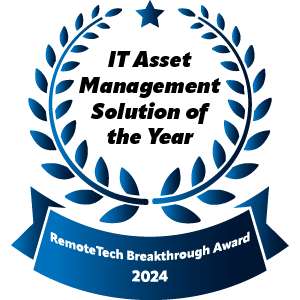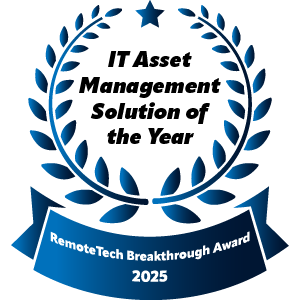The Horror Stories of IT Asset Management (ITAM)
When visibility fades, nightmares begin. Don’t fall prey to these ITAM Horror Stories.
As the chill of autumn settles in and Halloween draws near, many of us embrace the eerie thrill of haunted houses and ghost stories. But in the business world, the scariest tales come not from specters, but from something far more insidious: losing sight of your IT assets as they transition through critical phases.
Offboarding employees, returning leased equipment, or preparing devices for disposal should be simple—but when visibility disappears, it’s easy for these processes to slip into chaos.
Drawing inspiration from some classic horror films in honor of the holiday, let’s explore the very real consequences of IT asset mismanagement, and how ReturnCenter can save your company from its worst IT nightmares.
The Rogue Assets of “Frankenstein”
Much like Dr. Frankenstein’s ill-fated creation, rogue IT assets can wreak havoc if they aren’t carefully monitored. We need to be especially vigilant with offsite devices ready for offboarding, refurbishment, or decommissioning. They can become lost or forgotten, spiraling out of control. In the confusion, assets go missing, deadlines are missed, and security vulnerabilities emerge.
Here, ReturnCenter steps in to restore order. The Box Program is especially helpful to collect assets from remote users, ensuring that individual devices like laptops are securely packaged and returned, avoiding potential chaos and loss during these transitions.
By tracking your IT assets as they make their way to their next destination—whether back to your facility, a leasing company, or an IT asset disposition partner — ReturnCenter ensures that no rogue assets are left to roam free.
The “Psycho” Data Breach: A Sudden Horror
There’s an almost visceral terror to the iconic shower scene in Psycho—that moment when safety and comfort are shattered by the suddenness of a surprise attack. Similarly, a data breach can strike when least expected, particularly if IT assets containing sensitive information are improperly handled or lost during offboarding or disposal.
With ReturnCenter, such horrors are kept at bay. Our logistics solution gives you the choice of simple pickup, packing, and tagging each individual asset, providing the exact level of security and tracking that works for you. Combined with the comprehensive dashboard, you have visibility into your assets’ whereabouts as they are securely transported to trusted ITAD partners. With ReturnCenter overseeing the process, the risk of sensitive information slipping through the cracks is minimized.
The “Night of the Living Dead” Hardware: The Undead Haunting Your Storage
There’s something uniquely unsettling about the idea of the undead—relics of the past that refuse to stay buried. In the IT world, outdated hardware can become your version of the undead, lingering long after their usefulness has ended.
Much like the zombies in Night of the Living Dead, legacy IT equipment can waste valuable resources, filling up storage space and draining your budget if not properly dealt with.
ReturnCenter ensures that these relics are laid to rest in a timely manner. By coordinating the movement of outdated devices—whether for recycling or for responsible disposition—we help your business avoid becoming a graveyard for “undead” hardware.
ReturnCenter for ServiceNow: Lifting the “Fog” of Uncertainty
In The Fog, thick mist shrouds the characters’ surroundings, hiding unseen threats and creating a sense of helplessness. Managing IT assets without full visibility can feel much the same. Without a comprehensive view of where assets are as they move through their lifecycle—whether during offboarding or relocation—your team may be left to navigate in the dark.
For those using ServiceNow, ReturnCenter for ServiceNow cuts through the fog. The ReturnCenter app in ServiceNow enables users to schedule, track, and report on transportation of hardware assets right in ServiceNow, avoiding the back and forth fog between unconnected systems. By integrating ReturnCenter’s powerful tracking capabilities directly into the ServiceNow ecosystem, you get real-time insights into your IT assets’ locations and status, ensuring they move smoothly through critical transitions without getting lost in the mist.
ReturnCenter Automate: Banishing the “Ghosts” of IT Asset Disposition
In Ghostbusters, the heroes face invisible threats causing chaos until they can be tracked and eliminated. Managing IT asset disposition can feel much the same—an invisible burden of manually recording every milestone, from state changes to uploading documents, creating a painstaking and error-prone process.
ReturnCenter Automate for ServiceNow offers a solution to this ghostly problem. By providing automatic updates on the state, substate, retired date, vendor disposal ID, and resale value of each asset in a disposition shipment, it eliminates the need for manual tracking.
Your IT team no longer has to chase down these details or worry about missing critical updates. Additionally, any related documentation uploaded by your ITAD partner is instantly available, giving you immediate access to critical information. With ReturnCenter Automate, the ghosts of IT asset management are banished, ensuring a smooth and transparent process.
The “Jaws” of Non-Compliance: Danger Below the Surface
In Jaws, the danger lies beneath the surface, waiting to strike when least expected. In the world of IT asset management, non-compliance risks often lurk unseen.
Whether due to improper tracking of assets during transitions or failure to meet regulatory requirements for disposal, businesses can find themselves facing steep fines and penalties when compliance issues rise to the surface.
ReturnCenter provides the oversight needed to avoid these hidden dangers. By carefully tracking your IT assets through every transition, we ensure that they are responsibly handled, helping your business stay in compliance with environmental regulations and data security standards. With ReturnCenter, there’s no need to fear what may be lurking beneath.
Put Your IT Lifecycle Nightmares to Rest
The most terrifying stories in IT asset management are those of lost visibility and control. Rogue assets, non-compliance, data breaches, outdated hardware, and lost productivity all loom large when your IT lifecycle is not properly managed. But with ReturnCenter, The ReturnCenter Box Program, ReturnCenter for ServiceNow, and ReturnCenter Automate, your business can rest assured that its assets will be easily tracked, managed, and securely transported at every step of the process.
This Halloween don’t let your IT assets become the stuff of nightmares. With ReturnCenter, you can ensure that your hardware remains visible, your processes stay compliant, and your transitions run smoothly, keeping all the real monsters at bay.



